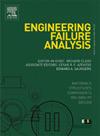无化合物93WNiFe合金/30CrMnSiA钢HIP扩散连接接头组织演变及力学性能改善
IF 4.4
2区 工程技术
Q1 ENGINEERING, MECHANICAL
引用次数: 0
摘要
利用NiFeWss夹层成功制备了超高性能的93WNiFe合金/30CrMnSiA钢热等静压扩散连接接头。采用扫描电镜(SEM)、透射电镜(TEM)和拉伸试验对接头的组织和性能进行了研究。基于Fick第二定律和Johnson-Mehl-Avrami-Kolmogorov (JMAK)理论,研究了界面元素扩散和相析出动力学。结果表明:接头组织为93WNiFe合金/(NiFeWSS基体+ W析出相)复合扩散层/钢,无脆性金属间化合物;随着键合温度从900℃升高到1050℃,扩散层中W析出相的体积分数从6.38%增加到21.54%,平均尺寸从0.86 μm增加到4.33 μm。W析出相体积分数的增加有助于降低接头最大拉应力,而平均尺寸的增加则起相反的作用。结果表明,随着连接温度的升高,接头的抗拉强度先升高后降低。在950℃的结合温度下,获得了412 MPa的超高抗拉强度和9.4%的延伸率。复合扩散层的形成可归因于元素在NiFeWSS中间层和钢基体之间的扩散,元素Fe从钢基体向NiFeWSS中间层的扩散速率为DFe = 3.58 × 10-6exp(−2.72 × 105/RT)m2/s,元素Ni从NiFeWSS中间层向钢基体的扩散速率为DNi = 7.65 × 10-6exp(−2.94 × 105/RT)m2/s, W相在900℃、950℃时在扩散层中析出。1000°C, 1050°C f = 1-exp(−4.23×10-4t0.58624), f = 1-exp(−7.42×10-5t0.85804), f = 1-exp(−1.83×10-4t0.77961),和f = 1-exp(−4.87×10-5t0.98385)。本文章由计算机程序翻译,如有差异,请以英文原文为准。
Microstructure evolution and mechanical property improvement of compound-free 93WNiFe alloy/30CrMnSiA steel joints via HIP diffusion bonding
In this work, the ultra-high performance 93WNiFe alloy/30CrMnSiA steel hot isostatic pressing diffusion bonding joint was prepared successfully by utilizing NiFeWss interlayer. The microstructures and properties of joints were researched by using scanning electron microscopy (SEM), transmission electron microscopy (TEM), and tensile testing. Residual thermal stresses of joints were researched by using Finite element (FE) simulation, the interface element diffusion and phase precipitation kinetics were studied based on Fick’s second law and Johnson-Mehl-Avrami-Kolmogorov (JMAK) theory. The results indicate that, the microstructure of joint is 93WNiFe alloy/(NiFeWSS matrix + W precipitated phases) composite diffusion layer/steel, without the brittle intermetallic compounds. With bonding temperature increases from 900 °C to 1050 °C, the volume fraction of W precipitated phase in diffusion layer increases from 6.38 % to 21.54 %, and the average dimension increases from 0.86 μm to 4.33 μm. The increasing volume fraction of W precipitated phases assist in reducing the maximum tensile stress in the joint, while the increase in average size plays an opposite role. As a result, the tensile strength of joint increases firstly and then decreases with the increasing bonding temperature. Ultra-high tensile strength of 412 MPa and elongation rate of 9.4 % were achieved at a bonding temperature of 950 °C. The formation of composite diffusion layer can be attributed to element diffusion between NiFeWSS interlayer and steel substrate, the diffusion rates for element Fe from steel substrate into NiFeWss interlayer and element Ni from NiFeWss interlayer into steel substrate are DFe = 3.58 × 10-6exp(−2.72 × 105/RT)m2/s and DNi = 7.65 × 10-6exp(−2.94 × 105/RT)m2/s, the precipitation of W phase in diffusion layer with bonding temperatures of 900 °C, 950 °C, 1000 °C and 1050 °C follows f = 1-exp(−4.23 × 10-4t0.58624), f = 1-exp(−7.42 × 10-5t0.85804), f = 1-exp(−1.83 × 10-4t0.77961), and f = 1-exp(−4.87 × 10-5t0.98385).
求助全文
通过发布文献求助,成功后即可免费获取论文全文。
去求助
来源期刊

Engineering Failure Analysis
工程技术-材料科学:表征与测试
CiteScore
7.70
自引率
20.00%
发文量
956
审稿时长
47 days
期刊介绍:
Engineering Failure Analysis publishes research papers describing the analysis of engineering failures and related studies.
Papers relating to the structure, properties and behaviour of engineering materials are encouraged, particularly those which also involve the detailed application of materials parameters to problems in engineering structures, components and design. In addition to the area of materials engineering, the interacting fields of mechanical, manufacturing, aeronautical, civil, chemical, corrosion and design engineering are considered relevant. Activity should be directed at analysing engineering failures and carrying out research to help reduce the incidences of failures and to extend the operating horizons of engineering materials.
Emphasis is placed on the mechanical properties of materials and their behaviour when influenced by structure, process and environment. Metallic, polymeric, ceramic and natural materials are all included and the application of these materials to real engineering situations should be emphasised. The use of a case-study based approach is also encouraged.
Engineering Failure Analysis provides essential reference material and critical feedback into the design process thereby contributing to the prevention of engineering failures in the future. All submissions will be subject to peer review from leading experts in the field.
 求助内容:
求助内容: 应助结果提醒方式:
应助结果提醒方式:


